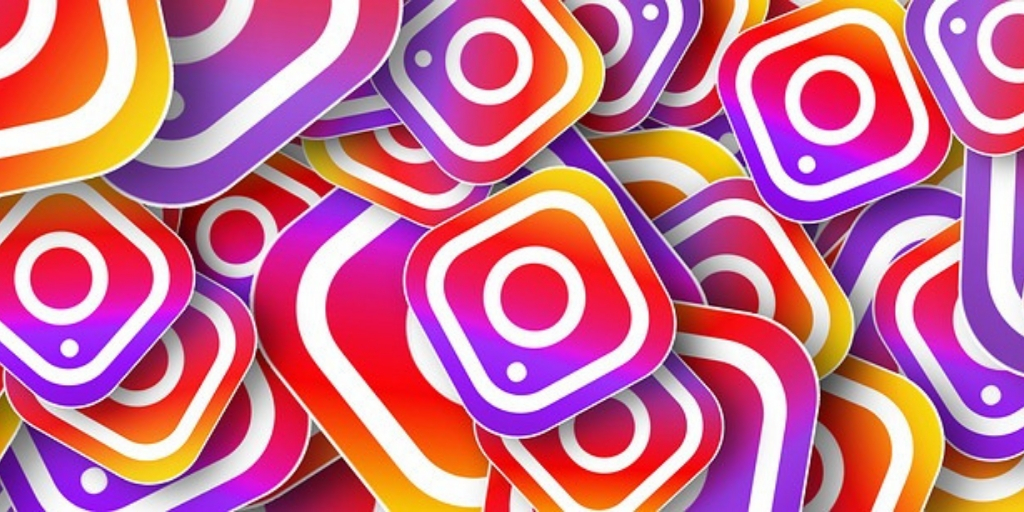
by Fronetics | Feb 19, 2019 | Marketing, Social Media
Need some Instagram for B2B marketing inspiration? These 10 brands are getting it right.
Highlights
- Instagram is a great opportunity for B2B businesses.
- Avoiding blatant sales or advertising pushes is key.
- Successful accounts engage users with interesting visuals and/or provide them with value through informative content.
Instagramnow boasts over 1 billion monthly active users, making it one of the most popular social media platforms out there. It’s a tremendous opportunity for businesses. In fact, recent research has shownthat 66% of brands now use Instagram.
But many B2B marketers are still struggling to find their footing on this highly visual platform. Since we could all use a little inspiration now and then, here are 10 brands that are crushing Instagram for B2B marketing — and what we like about their presence.
10 brands that are nailing Instagram for B2B marketing
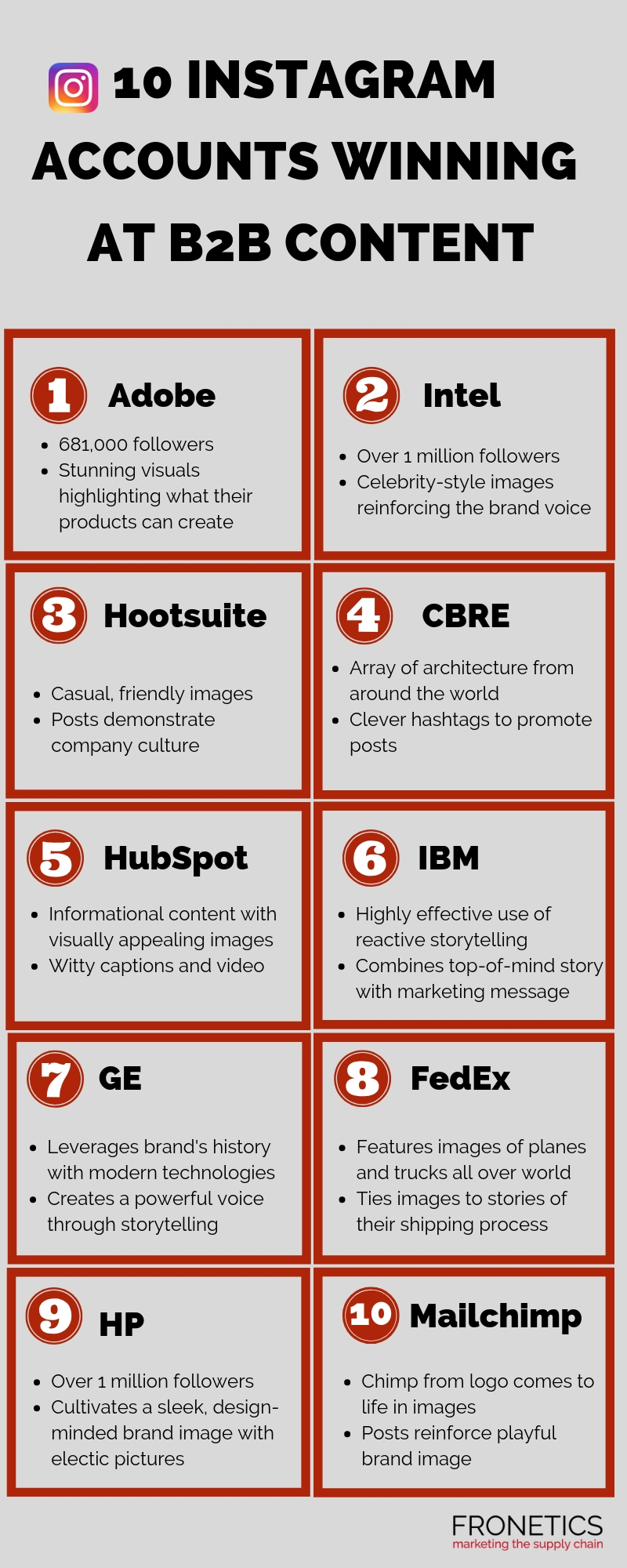
(Made with Canva)
1) Adobe
With 681k followers, Adobe (@adobe) is a fortunate brand when it comes to Instagram in that its product naturally lends itself to the visual medium. Its account boasts some truly stunning visuals, highlighting what Adobe products can create.
2) Intel
The tech giant Intel (@intel) cultivates a celebrity-style image, giving its over-a-million followers an inside glimpse into big events the brand plays a role in, like the X Games, Grammys, and glitzy tech conferences. Each of the carefully curated images reinforces the brand’s voice, and captions do a great job of detailing exactly what the brand does in the tech space.
3) Hootsuite
Social media management dashboard Hootsuite (@hootsuite) does a fantastic job of showing brands their social media know-how, right in its Instagram profile. The company cultivates a casual, friendly image and posts content that demonstrates company culture. From team building photos to office dogs, Hootsuite makes followers feel like they’re getting to know the brand.
4) CBRE
Global commercial real estate firm CBRE (@cbre) is a phenomenal example of finding beauty within the context of its operations. The brand’s Instagram feed features a stunning array of architecture from around the world, with clever use of hashtags.
5) HubSpot
Here’s a company getting content Instagram for B2B marketing right. HubSpot (@hubspot) consistently provides value to followers, posting informational content. Rather than letting it get boring, the brand keeps content visually appealing and makes clever use of captioning and video.
6) IBM
Tech juggernaut IBM (@ibm) has made highly effective use of reactive storytelling on Instagram. This method of storytelling combines a top-of-mind story or idea with a compelling marketing message. IBM uses it during popular or inspiring events, demonstrating how it’s making use of the brand’s technology.
7) General Electric
It’s a household name brand, and it’s over a century old. General Electric’s (@generalelectric) Instagram presences does a great job of leveraging the brand’s history, highlighting its involvement with important developments in defense, aviation, and technology. It’s a great example of creating a powerful voice from a brand through storytelling and tapping into the audience’s nostalgia.
8) FedEx
FedEx (@fedex) is a prime example of a B2B brand that makes the absolute most of what it does to create a compelling story for its Instagram content. The account features photos of airplanes and trucks all over the world, telling the story of how the carrier cares for and ships products in its care.
9) HP
With over a million followers HP (@hp) cultivates a sleek, design-minded brand image on Instagram. It capitalizes on subtlety and style, with eclectic images that never feel overtly promotional but that highlight the brand’s innovation.
10) Mailchimp
Email marketing company Mailchimp (@mailchip) truly gets the most out of its whimsical logo. Its Instagram content has given the playful chimp logo life and transformed him into a personality and voice for the brand. The image is quirky and fun, and Mailchimp’s Instagram presence reinforces and capitalizes on that.
What companies do you think are doing Instagram for B2B marketing right?
Related posts:
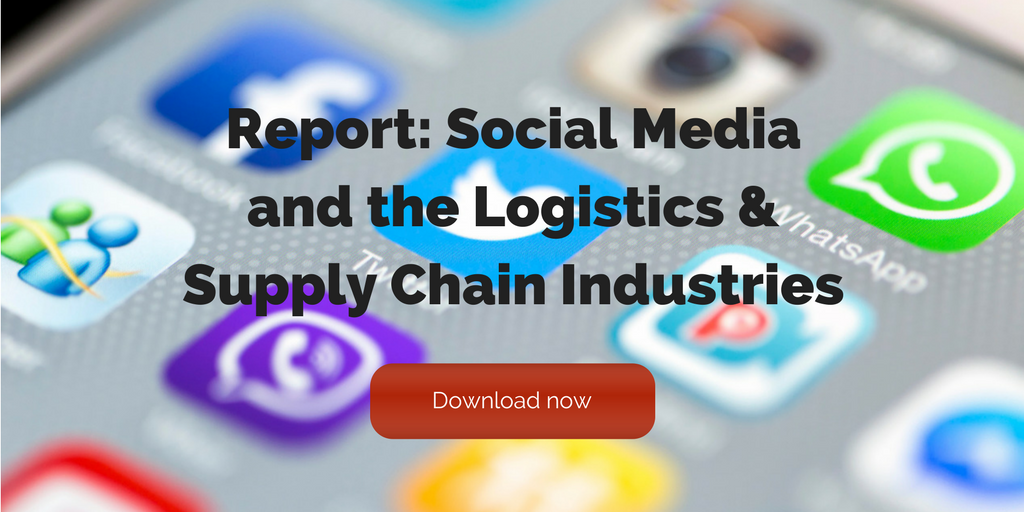
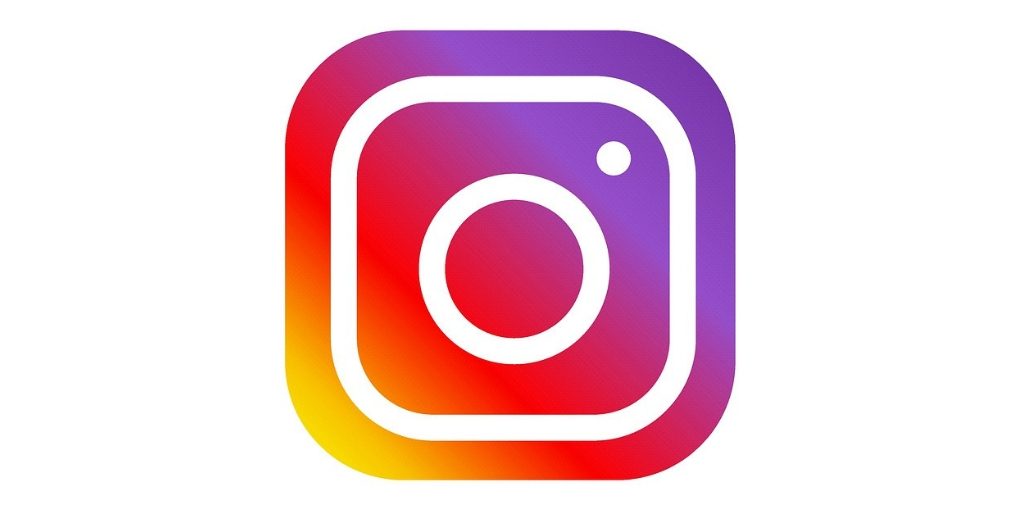
by Fronetics | Feb 7, 2019 | Blog, Content Marketing, Logistics, Marketing, Social Media, Supply Chain
Looking to boost followers on Instagram? These tips will help supply chain marketers grow their following, build brand awareness, and nurture a loyal audience base.
Highlights
- Instagram has over 500 million daily users.
- Fake accounts won’t help in the long run.
- Growing authentic followers requires commitment and strategy.
While it’s true that Facebook is a favorite for B2B marketing, don’t overlook Instagram. Over 500 million users browse the app daily — some of the most engaged audiences on the web. This is absolutely a powerful resource for supply chain marketers, and if you aren’t already, it’s time you start tapping into it.
But as with all social media platforms, there’s a right and a wrong way to go about using it. When it comes to Instagram, getting the most out of the platform has a lot to do with boosting followership.
Keep in mind that recent studies have shown that roughly 48 million Instagram users are fake. Inflating your audience with fake followers won’t serve you well.
Boosting engagement and growing your following takes time and strategy. The 10 tips in our infographic below will help you get the most out of Instagram, building an authentic, engaged audience.
10 tips to boost followers on Instagram
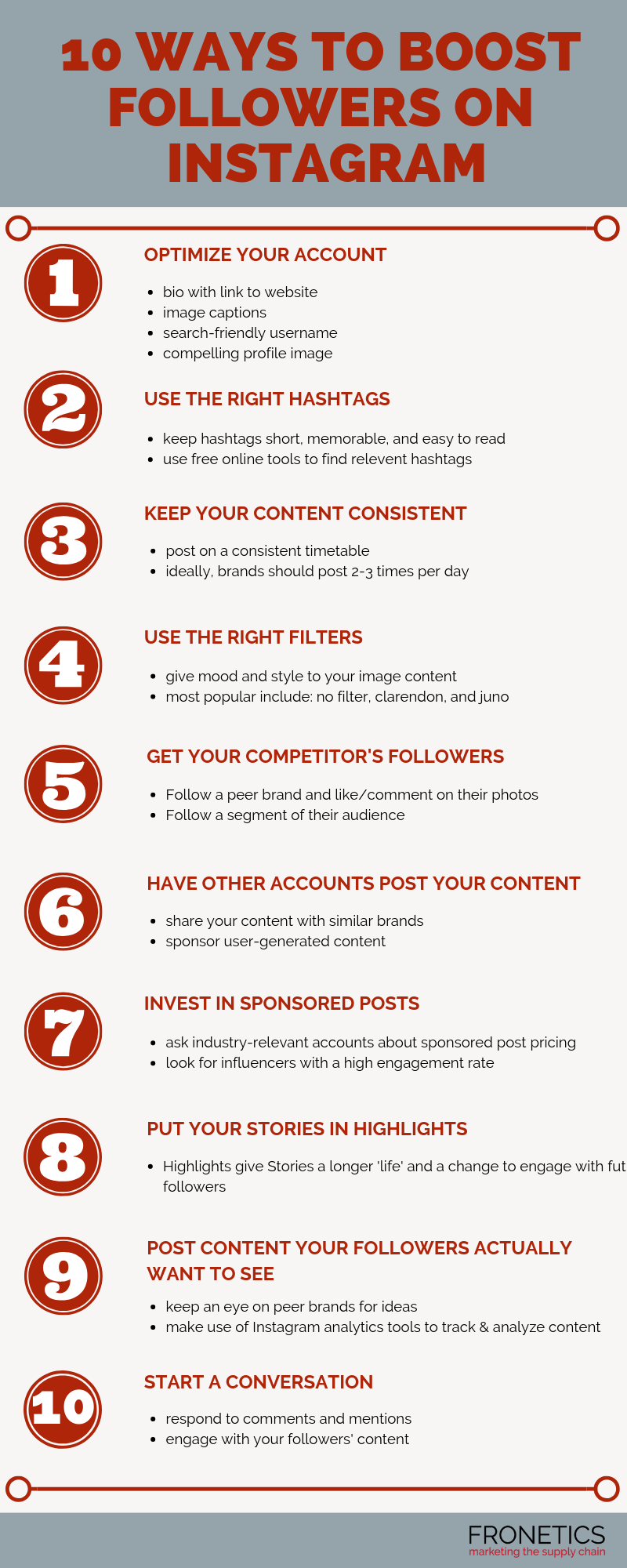
(Made with Canva)
1) Optimize your account
Before we get to anything fancy, take a step back and make sure your Instagram account is fully optimized. This means you need:
- a bio with a link to marketing or product pages related to a specific keyword or hashtag
- image captions, which can reference the link in your bio
- a search-friendly username
- a compelling profile image that reflects your brand
2) Use the right hashtags
One of the most effective ways to grow your Instagram following is to use hashtags effectively. Since Instagram gives users the ability to follow hashtags that interest them, and they function as links to other relevant content, choosing the right hashtags is the ideal way to reach and engage your target audience.
Keep an eye on accounts of peer brands to stay up to date with the best hashtags to be using. The most effective hashtags are short, memorable, and easy to read. You can also use a free online tool like InconoSquare or Websta to find relevant hashtags for the supply chain and logistics industries.
3) Keep your content consistent
Posting on a consistent timetable is crucial to maintaining an active following. Posting irregularly means you risk your followers forgetting about you. And posting all at once can annoy and drive followers away. Ideally, brands should post 2-3 times a day. For more, check out our guide to when to post on social media.
4) Use the right filters
We all know that playing with filters is fun. These lighting and color presets offered by Instagram have the potential to create mood and style in your image content. According to Iconosquare, these 10 filters are currently the most popular on Instagram. And it turns out that the filters you choose really do have an impact on engagement.
- Normal (No Filter)
- Clarendon
- Juno
- Lark
- Ludwig
- Gingham
- Valencia
- X-Pro II
- Lo-fi
- Amaro
5) Get your competitors’ followers
Maybe it sounds like a dirty trick, but hear us out! Users who have already shown an interest in similar brands to yours are an ideal audience base. Engaging with them is a great way to grow your own following. Identify a peer brand with a healthy Instagram following; follow a segment of their audience; and like or comment on their photos. Keep track of how many users follow your brand back.
6) Have other accounts post your content
Operating on the principle that followers of similar accounts to yours are an ideal audience base, getting these accounts to post your content is a great way to boost your followership. One way to do this is to sponsor user-generated content to get your brand in customers’ feeds. For example, hold a photo contest related to your brand, encouraging followers to post and caption your content.
7) Invest in sponsored posts and product reviews
Optimizing your account and following Instagram best practices will go a long way toward getting authentic followers. But to really boost your followers on Instagram, it pays to take advantage of influencer marketing on Instagram. Create a list of large accounts in your industry, follow them, reach out to their marketing team, and ask about sponsored post pricing. Be on the lookout for influencers with a high engagement rate relative to number of followers.
8) Put your Stories in Highlights
In addition to its Stories feature, Instagram now lets users create a featured group of “Highlights” in various categories on their profile. Stories have only a 24-hour lifespan, so featuring your most effective Stories clips in Highlights gives them a second life and a chance to engage future followers. One of the best features of Stories and Highlights is that they allow brands to view and analyze how users have viewed and interacted with their content.
9) Post content your followers actually want to see
This one may sound painfully obvious, but it’s harder than it looks. Because brands need to publish content consistently to maintain an active Instagram following, it can be extremely difficult to generate fresh, interesting content consistently. There’s no easy trick to this one. Keep an eye on peer brands, and make use of Instagram analytics tools to track, analyze, and benchmark Instagram content.
10) Start a conversation
It’s easy to forget that the fundamental benefit of social media is that it’s social. Users want to be part of a conversation. Encourage your followers to interact with you on all your social media platforms, including Instagram. This means responding to comments and brand mentions, as well as engaging with your followers’ content.
Final thoughts
Instagram is an extremely effective tool for supply chain marketers. These 10 tips to boost followers on Instagram will help you create and nurture a loyal, engaged audience base. In turn, an effective Instagram presence has the potential to grow brand awareness, improve your reputation, and generate qualified leads.
Related posts:


by Fronetics | Jan 29, 2019 | Blog, Content Marketing, Logistics, Marketing, Social Media, Supply Chain
Knowing the right video distribution channels can go a long way toward driving traffic and getting your content to your target audience.
Highlights:
- An effective video distribution strategy is key to success.
- Choose video distribution channels that match your marketing goals.
- Paid ads can give video an extra boost.
Video transcript:
I’m Christy Lemire, the Director of Video Marketing here at Fronetics. Today we’re going to be talking about the four best distribution platforms for video.
Here are the four best platforms for distributing your marketing videos.
1. Your network
Don’t underestimate the power of your own existing network. Send your videos, via email, to your primary contacts and everyone in your current database.
2. Social media
Platforms like Facebook, Instagram, Twitter, Snapchat, and of course YouTube are great to reach your target audience. Of course within the category of social media, you want to consider what platforms suit your content best. YouTube is a great place to start, but there are also many industry specific online forums and social groups that can benefit you as well.
3. Blogs
Promote your video on your own blog to reach your followers and boost your SEO. It’s also a good idea to distribute your video on other industry specific blogs to overlap your target audience.
4. Paid ads
While the first three channels of distribution we discussed are organic, sometimes it is well worth it to use paid ads to give your content a significant boost, such as Google Adwords and AdSense.
Bottom line is using the right distribution channels helps you get the most out of your video marketing efforts. For more information about video marketing, visit Fronetics.com.
Related posts:


by Fronetics | Jan 23, 2019 | Blog, Current Events, Logistics, Marketing, Social Media, Supply Chain
Supply chain and logistics companies: here are your key takeaways on digital marketing trends from the Content Marketing Institute’s 2019 survey.
Highlights:
- For 2019, resolve to put your audience first.
- Building audience trust is crucial.
- Make sure your content is performing well by keeping pace with changes to search engines.
The Content Marketing Institute has published its ninth annual survey, giving insight into the most significant digital marketing trends and priorities for 2019. We’ll get into some key takeaways in detail, but perhaps the most striking finding was one that we’ve been talking about for years.
Of the top performing B2B marketers surveyed, the vast majority (90%) reported that they “prioritize the audience’s informational needs over their sales/promotional message.” That’s a powerful statistic. And when you consider that of the least successful B2B marketers, only 56% doing the same, it’s hard not to agree that the success gap is accounted for by this prioritization.
Digital marketing trends in 2019: making the audience a priority
Looking at the key trends from 2018, which will set the pace for 2019, some overall themes emerge. Foremost among them is the need to put audiences first. When 96% of the most successful B2B marketers report that their organizations have “built credibility and trust with their audience,” it indicates that those organizations have been highly effective at listening to their audiences and delivering value with their content.
Savvy marketers going forward will devote time and resources to researching the needs of their audience. Currently, only 23% of marketers are using email to encourage audience participation, build community, and bring new perspectives to their efforts. Not only that, but only 42% report seeking conversations with customers as a form of audience research.
Successful marketers in 2019 will lead the charge, putting email and other forms of digital marketing to use not only to publish their own content, but to form a deeper understanding of the needs and perspectives of their audience.
3 key digital marketing trends for 2019
1) Email campaigns and educational content win the day.
The majority (58%) of CMI’s survey respondents report that they have successfully used content marketing to nurture subscribers, audience, or leads within the past year. Their most successful methods were email (87%) and educational content (77%).
[bctt tweet=”When it comes to building trust among your audience, and nurturing relationships with prospects, educational content can be your best friend.” username=”Fronetics”]
We’ve written before about the overwhelming preference among B2B buyers for educational content like case studies. When it comes to building trust among your audience, and nurturing relationships with prospects, educational content can be your best friend. Similarly, email marketing, when used strategically, is an ideal way to usher prospects down the sales funnel with your content. For more insights, take a look through our top 7 email marketing posts from 2018.
2) Video continues to gain popularity.
We talk a lot about the value of video marketing for the supply chain. Once again this year, video has continued to increase its popularity. More than 50% of survey respondents increased their use of video marketing. Interestingly, a majority also bumped up their use of text-based digital marketing, as well as images (such as infographics, photos, and charts).
Video is on the rise all over the internet, and it gets easier all the time to create focused, engaging, and creative video content to market your business. That being said, successful B2B companies in the supply chain are increasingly outsourcing tasks like videography in order to ensure optimal video strategy, creation, production, and distribution across social media and content platforms.
3) SEO and search algorithms are a concern.
CMI’s survey asked about content marketing issues that organizations are concerned about and found that 61% are worried about changes to SEO/search algorithms. A significant minority (45%) are also concerned about changes to social media algorithms.
It’s true that just as people are changing how they search, search engines themselves are shifting their algorithms, becoming more sophisticated, and making the simple keyword model rapidly outmoded. Keeping up with the change can be overwhelming, but resources exist to help you. Our four-part series on writing for SEO can help you adjust your strategies and provides guidance on topic clusters and pillar content, as well as how to evaluate the success of your content.
What other digital marketing trends are you looking out for in 2019?
Related posts:


by Fronetics | Jan 17, 2019 | Blog, Content Marketing, Logistics, Marketing, Supply Chain
Blogging should be a central part of your content marketing strategy. Here are our top tips for creating and sustaining a successful supply chain blog in 2019.
Highlights:
- Blogging needs to be a central part of your content marketing strategy.
- Focus on quality over quantity.
- Make all posts mobile-friendly.
It’s the start of a new year and the perfect time to start setting goals and strategizing how to achieve them. Hopefully, blogging is a big part of your strategy for 2019 — after all, supply chain companies should make blogging a central part of their content marketing strategy for all kinds of reasons.
[bctt tweet=”At last count, users share 27 million pieces of new content on social media every single day. Twenty-seven million!” username=”Fronetics”]
Making your supply chain blog stand out from the pack isn’t always easy. That’s why we created the infographic below. Read on for our top 5 supply chain blogging tips for 2019.
5 tips for your supply chain blog
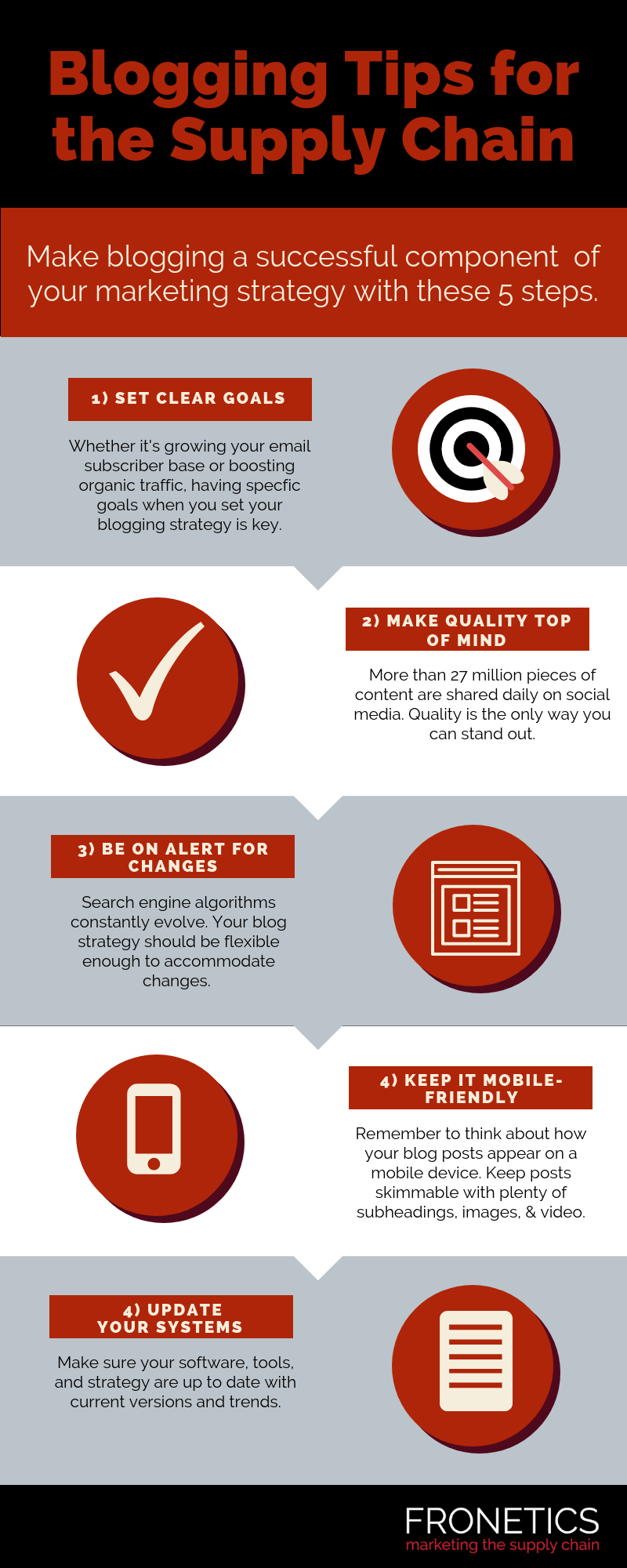
(Made with Canva)
1. Set clear goals
We know, this one sounds obvious. But you’d be surprised how often marketers overlook this seemingly simple step or settle for general, vague goals. It’s true that blogging can have all kinds of positive impacts for the supply chain, but that doesn’t mean that you should just be blogging without a clear, documented set of goals specific to your business.
Whether it’s growing your email subscriber base, boosting organic traffic, or generating more qualified leads, having specific goals in mind when you set your blogging strategy is key. For one thing, it lets you target your efforts and generate content that is focused on achieving a specific result or set of results. Furthermore, having objectives allows you to be far more effective in evaluating your results, including measuring blogging ROI, and tweak your strategy accordingly.
What are your top three goals for your supply chain blog in 2019? Let us know in the comments!
2. Make quality top of mind
Ponder this for a minute: At last count, users share 27 million pieces of new content on social media every single day. Twenty-seven million. In a world of skyrocketing quantity, quality is ever-more important. There’s a huge amount of pressure on supply chain marketers to produce a constant stream of content, but the sad truth is, if you’re not producing high-quality, substantive content, you’re wasting time and energy.
For supply chain companies in particular, it’s crucial that every piece of your content be well-researched, clearly written, focused, and trustworthy. We know that producing consistently high-quality content isn’t easy, but, trust us: if you invest the time and energy to make your content stand out, you will see the results. To get you started or keep you focused, check out our guide to creating good content for logistics and supply chain marketers.
3. Be on the alert for changes
Particularly when it comes to search engine optimization (SEO), changes happen fast these days. In August of 2017, Google updated its algorithm, continuing a set of changes we’ve been watching for a while now. Voice searches are becoming increasingly prevalent, and researchers estimate that by 2020, 50% of all searches will be voice queries.
As these changes continue to happen, it’s crucial that your strategy is lithe and flexible, ready to adapt to a quickly shifting climate. This means keeping abreast of conversations going on in the industry, following blogs you trust and respect, as well as tracking your own results, and being alert to changing trends.
4. Keep it mobile-friendly
You don’t need researchers to tell you: people are increasingly receiving and reading content on their phones. Whether it’s social media, emails, or blogs, mobile usage continues to skyrocket as devices become more and more ubiquitous and user-friendly.
What does this mean for supply chain blogs? Of course, your website needs to have a visually attractive and accessible mobile version, but it’s also helpful to think about your blog posts in terms of how they appear on a phone. Keep your posts skimmable, with plenty of subheadings to orient the reader, and absolutely include video whenever possible.
5. Make sure your systems are up to date
We keep coming back to the reality of the rate of change these days. It can be exhausting and overwhelming for marketers to keep pace. Take the opportunity of the new year to make sure all your blogging-related tools are updated and running the current software.
As you’re keeping your tools fresh, it’s also a good time to make sure your procedures are running smoothly and are at a pace with the current marketing climate. This means evaluating responsibilities and results within your team, ensuring that your editorial calendar is serving you well, and taking a look at your data collection and reporting methods.
Bonus: What not to do in 2019
These might seem obvious, but again, you’d be surprised how may marketers fall victim to these blogging “don’ts.” We figured it bore repeating.
- Don’t: attempt to post content that doesn’t reflect your business’ “comfort zone.” Stick to what you know, and do it well.
- Don’t: copy and paste text or images from other blogs. Using other content for ideas is great. Copying it verbatim is verboten.
- Don’t: post at irregular intervals. Creating a content schedule and sticking it is key to establishing a loyal following and boosting your credibility.
What goals do you have for your supply chain blog this year?
Related posts:













